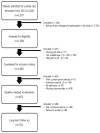Long-Term Follow-Up of Intensive Integrative Treatment including Motion Style Acupuncture Treatment (MSAT) in Hospitalized Patients with Lumbar Disc Herniation: An Observational Study
- PMID: 36553986
- PMCID: PMC9777699
- DOI: 10.3390/healthcare10122462
Long-Term Follow-Up of Intensive Integrative Treatment including Motion Style Acupuncture Treatment (MSAT) in Hospitalized Patients with Lumbar Disc Herniation: An Observational Study
Abstract
This study aimed to investigate the long-term effects of and satisfaction with integrative Korean medicine treatment and motion style acupuncture treatment (MSAT) in patients with lumbar disc herniation (LDH). We retrospectively analyzed medical charts and prospectively surveyed adult patients aged between 19 and 64 years treated for lumbar disc herniation for at least 6 days at three Korean hospitals from 1 January 2015 to 31 December 2020. The primary outcome was the Numeric Rating Scale (NRS) for back pain. Secondary outcome measures included the NRS for radiating leg pain, the Oswestry Disability Index (ODI), and the European Quality of Life-5 Dimension-5 Level (EQ-5D-5L) questionnaire. The NRS scores for low back pain decreased from 5.40 ± 1.58 to 2.92 ± 2.09, NRS for radiating leg pain from 5.57 ± 1.56 to 1.78 ± 2.36, and ODI from 46.39 ± 16.72 to 16.47 ± 15.61 at baseline and survey, respectively. The EQ-5D-5L increased from 0.57 ± 0.19 to 0.82 ± 0.14. In conclusion, Korean medicine and MSAT could be effective treatment methods for patients with LDH. The results of this study can be used as helpful information for clinicians who treat patients with LDH in real clinical settings.
Keywords: integrative treatment; lumbar disc herniation; motion style acupuncture treatment; surveys and questionnaires.
Conflict of interest statement
The authors declare no conflict of interest.
Figures



Similar articles
-
Effectiveness and safety of motion style acupuncture treatment of the pelvic joint for herniated lumbar disc with radiating pain: A prospective, observational pilot study.Explore (NY). 2022 Mar-Apr;18(2):240-249. doi: 10.1016/j.explore.2021.09.004. Epub 2021 Sep 29. Explore (NY). 2022. PMID: 34674966
-
Which clinical and radiological variables could predict clinical outcomes of percutaneous endoscopic lumbar discectomy for treatment of patients with lumbosacral disc herniation?Spine J. 2018 Aug;18(8):1338-1346. doi: 10.1016/j.spinee.2017.12.010. Epub 2017 Dec 29. Spine J. 2018. PMID: 29292235
-
Effectiveness of motion style acupuncture treatment for patients with shoulder disorders: A prospective observational study.Explore (NY). 2023 Nov-Dec;19(6):832-841. doi: 10.1016/j.explore.2023.04.011. Epub 2023 May 25. Explore (NY). 2023. PMID: 37353458
-
Criteria for failure and worsening after surgery for lumbar disc herniation: a multicenter observational study based on data from the Norwegian Registry for Spine Surgery.Eur Spine J. 2017 Oct;26(10):2650-2659. doi: 10.1007/s00586-017-5185-5. Epub 2017 Jun 14. Eur Spine J. 2017. PMID: 28616747
-
The Effectiveness and safety of T-MSAT on inpatients with acute low back pain caused by traffic accidents: A protocol for randomized controlled trial.Medicine (Baltimore). 2021 Feb 5;100(5):e23851. doi: 10.1097/MD.0000000000023851. Medicine (Baltimore). 2021. PMID: 33592841 Free PMC article.
References
LinkOut - more resources
Full Text Sources

